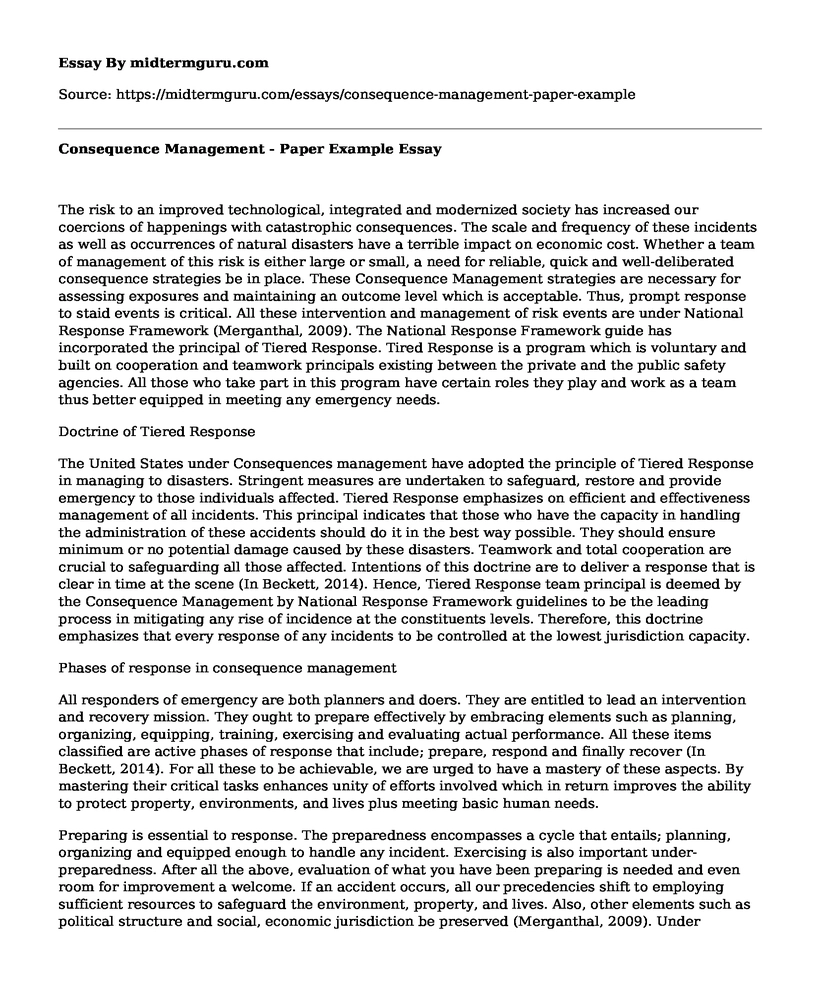The risk to an improved technological, integrated and modernized society has increased our coercions of happenings with catastrophic consequences. The scale and frequency of these incidents as well as occurrences of natural disasters have a terrible impact on economic cost. Whether a team of management of this risk is either large or small, a need for reliable, quick and well-deliberated consequence strategies be in place. These Consequence Management strategies are necessary for assessing exposures and maintaining an outcome level which is acceptable. Thus, prompt response to staid events is critical. All these intervention and management of risk events are under National Response Framework (Merganthal, 2009). The National Response Framework guide has incorporated the principal of Tiered Response. Tired Response is a program which is voluntary and built on cooperation and teamwork principals existing between the private and the public safety agencies. All those who take part in this program have certain roles they play and work as a team thus better equipped in meeting any emergency needs.
Doctrine of Tiered Response
The United States under Consequences management have adopted the principle of Tiered Response in managing to disasters. Stringent measures are undertaken to safeguard, restore and provide emergency to those individuals affected. Tiered Response emphasizes on efficient and effectiveness management of all incidents. This principal indicates that those who have the capacity in handling the administration of these accidents should do it in the best way possible. They should ensure minimum or no potential damage caused by these disasters. Teamwork and total cooperation are crucial to safeguarding all those affected. Intentions of this doctrine are to deliver a response that is clear in time at the scene (In Beckett, 2014). Hence, Tiered Response team principal is deemed by the Consequence Management by National Response Framework guidelines to be the leading process in mitigating any rise of incidence at the constituents levels. Therefore, this doctrine emphasizes that every response of any incidents to be controlled at the lowest jurisdiction capacity.
Phases of response in consequence management
All responders of emergency are both planners and doers. They are entitled to lead an intervention and recovery mission. They ought to prepare effectively by embracing elements such as planning, organizing, equipping, training, exercising and evaluating actual performance. All these items classified are active phases of response that include; prepare, respond and finally recover (In Beckett, 2014). For all these to be achievable, we are urged to have a mastery of these aspects. By mastering their critical tasks enhances unity of efforts involved which in return improves the ability to protect property, environments, and lives plus meeting basic human needs.
Preparing is essential to response. The preparedness encompasses a cycle that entails; planning, organizing and equipped enough to handle any incident. Exercising is also important under-preparedness. After all the above, evaluation of what you have been preparing is needed and even room for improvement a welcome. If an accident occurs, all our precedencies shift to employing sufficient resources to safeguard the environment, property, and lives. Also, other elements such as political structure and social, economic jurisdiction be preserved (Merganthal, 2009). Under responding phase, it entails the following; maintaining and gaining situational awareness, activating and deploying enough national and federal capabilities and resources, coordinating available response actions and demobilizing resources when the incident is in control. Finally, Recovery phase is the final one. It entails supporting all the affected to meet their daily basic needs and gaining their self-sufficiency. Recovery may be short term or long term. But for short term has to be immediate and always overlaps with a response. For the long run, it is outside the jurisdiction of National Response Framework.
Incident
September 11 is the most vivid one, which was a coordinated attack by terrorists. Consequences management employed among them responding team and recovery team. The responding team was dispatched in full gear with both men on the ground and even use of airplanes to try and safeguard the lives of people, their properties, and the environment. They had sufficient resources to handle the terrorist attack and managed to respond efficiently and were successful in containing the aftermath of the assault. For the phase of recovery, they saved many lives; the injured were first attended to by paramedics and rushed to various hospitals. The fire was put off. Guidance and counseling sessions were also set up in full gear to counsel all those who were affected.
The most important stage in all these phases is the recovery one. At least this aspect helps those affected be rehabilitated and resume their normal life.
References
In Beckett, D. (2014). National response and disaster recovery frameworks.
Merganthal, P. B., Jenkins, W. O., United States, & United States. (2009). National emergency responses. New York: Nova Science.
United States. (2008). National response framework. Washington, D.C: U.S. Dept. of Homeland Security.
Cite this page
Consequence Management - Paper Example. (2021, May 26). Retrieved from https://midtermguru.com/essays/consequence-management-paper-example
If you are the original author of this essay and no longer wish to have it published on the midtermguru.com website, please click below to request its removal:
- Recycling in Houston Is a Problem - Essay Example
- Essay on Hazards Impact Womens Reproductive Health
- Essay Sample on Weather and Climate
- Essay Sample on Business Resiliency: Hurricane Sandy
- Preparing for Disaster: Insurance and Management Plan - Essay Sample
- Carlton Watkins: Instrumental in Advocating for Environmentalism - Essay Sample
- Sustainability: What Stands in the Way of a Pollution-Free Planet? - Essay Sample







